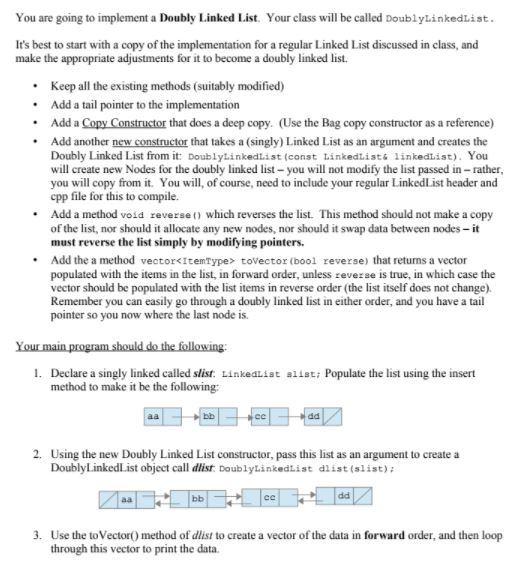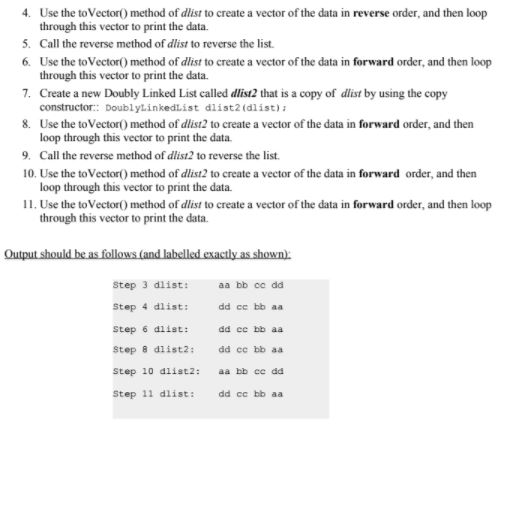Question
Write a C program for the following question. Codes are given below. Deep Copy Constructor reference Code: ***Just a REFERENCE*** LinkedBag::LinkedBag(const LinkedBag& aBag) { itemCount
Write a C program for the following question. Codes are given below.


Deep Copy Constructor reference Code: ***Just a REFERENCE***
LinkedBag::LinkedBag(const LinkedBag& aBag)
{
itemCount = aBag.itemCount;
Node* origChainPtr = aBag.headPtr; // Points to nodes in original chain
if (origChainPtr == nullptr)
headPtr = nullptr; // Original bag is empty
else
{
// Copy first node
headPtr = new Node();
headPtr->setItem(origChainPtr->getItem());
// Copy remaining nodes
Node* newChainPtr = headPtr; // Points to last node in new chain
origChainPtr = origChainPtr->getNext(); // Advance original-chain pointer
while (origChainPtr != nullptr)
{
// Get next item from original chain
ItemType nextItem = origChainPtr->getItem();
// Create a new node containing the next item
Node* newNodePtr = new Node(nextItem);
// Link new node to end of new chain
newChainPtr->setNext(newNodePtr);
// Advance pointer to new last node
newChainPtr = newChainPtr->getNext();
// Advance original-chain pointer
origChainPtr = origChainPtr->getNext();
} // end while
newChainPtr->setNext(nullptr); // Flag end of new chain
} // end if
} // end copy constructor
LinkedList.cpp Code:
#include "LinkedList.h"
#include
LinkedList::LinkedList() : headPtr(nullptr), itemCount(0)
{
} // end default constructor
void LinkedList::clear()
{
while (!isEmpty())
remove(1);
} // end clear
int LinkedList::getLength() const
{
return itemCount;
} // end getLength
bool LinkedList::isEmpty() const
{
return itemCount == 0;
} // end isEmpty
ItemType LinkedList::getEntry(int position) const
{
bool ableToGet = (position >= 1) && (position
if (ableToGet)
{
Node* nodePtr = getNodeAt(position);
return nodePtr->getItem();
}
else
{
std::string message = "getEntry() called with an empty list or ";
message = message + "invalid position.";
throw(message);
}
} // end getEntry
bool LinkedList::insert(int newPosition, const ItemType& newEntry)
{
bool ableToInsert = (newPosition >= 1) && (newPosition
if (ableToInsert)
{
// Create a new node containing the new entry
Node* newNodePtr = new Node(newEntry);
// Attach new node to chain
if (newPosition == 1)
{
// Insert new node at beginning of chain
newNodePtr->setNext(headPtr);
headPtr = newNodePtr;
}
else
{
// Find node that will be before new node
Node* prevPtr = getNodeAt(newPosition - 1);
// Insert new node after node to which prevPtr points
newNodePtr->setNext(prevPtr->getNext());
prevPtr->setNext(newNodePtr);
}
itemCount++; // Increase count of entries
}
return ableToInsert;
} // end insert
bool LinkedList::remove(int position)
{
bool ableToRemove = (position >= 1) && (position
if (ableToRemove)
{
Node* curPtr = nullptr;
if (position == 1)
{
// Remove the first node in the chain
curPtr = headPtr; // Save pointer to node
headPtr = headPtr->getNext();
}
else
{
// Find node that is before the one to remove
Node* prevPtr = getNodeAt(position - 1);
// Point to node to remove
curPtr = prevPtr->getNext();
// Disconnect indicated node from chain by connecting the
// prior node with the one after
prevPtr->setNext(curPtr->getNext());
}
// Return node to system
curPtr->setNext(nullptr);
delete curPtr;
curPtr = nullptr;
itemCount--; // Decrease count of entries
}
return ableToRemove;
} // end remove
ItemType LinkedList::replace(int position, const ItemType& newEntry)
{
bool ableToReplace = (position >= 1) && (position
if (ableToReplace)
{
Node* entryPtr = getNodeAt(position);
ItemType oldEntry = entryPtr->getItem();
entryPtr->setItem(newEntry);
return oldEntry;
}
else
{
std::string message = "replace() called with an empty list or ";
message = message + "invalid position.";
throw(message);
}
} // end replace
Node* LinkedList::getNodeAt(int position) const
{
// Debugging check of precondition
assert( (position >= 1) && (position
// Count from the beginning of the chain
Node* curPtr = headPtr;
for (int skip = 1; skip
curPtr = curPtr->getNext();
return curPtr;
} // end getNodeAt
LinkedList::~LinkedList()
{
clear();
} // end destructor
LinkedList.h Code:
#ifndef LINKED_LIST_
#define LINKED_LIST_
#include "Node.h"
#include
using namespace std;
typedef int ItemType;
class LinkedList
{
private:
Node* headPtr; // Pointer to first node in the chain;
int itemCount; // Current count of list items
// Locates a specified node in this linked list.
Node* getNodeAt(int position) const;
public:
LinkedList();
// Copy constructor and destructor are supplied by compiler
bool isEmpty() const;
int getLength() const;
bool insert(int newPosition, const ItemType& newEntry);
bool remove(int position);
void clear();
ItemType getEntry(int position) const;
ItemType replace(int position, const ItemType& newEntry);
virtual ~LinkedList();
}; // end ArrayList
#endif
LinkedListTest.cpp Code:
#include "LinkedList.h"
#include
int main()
{
LinkedList list;
for (int i = 1; i
{
list.insert(i, 100 + i);
}
cout
cout
list.remove(3);
cout
int entry = list.getEntry(3);
cout
list.replace(3, 999);
entry = list.getEntry(3);
cout
cout
for (int i = 1; i
{
cout
}
cout
list.clear();
cout
cout
}
Node.cpp Code:
#include "Node.h"
Node::Node() : next(nullptr)
{
} // end default constructor
Node::Node(const ItemType& anItem) : item(anItem), next(nullptr)
{
} // end constructor
Node::Node(const ItemType& anItem, Node* nextNodePtr) :
item(anItem), next(nextNodePtr)
{
} // end constructor
void Node::setItem(const ItemType& anItem)
{
item = anItem;
} // end setItem
void Node::setNext(Node* nextNodePtr)
{
next = nextNodePtr;
} // end setNext
ItemType Node::getItem() const
{
return item;
} // end getItem
Node* Node::getNext() const
{
return next;
} // end getNext
Node.h Code:
#ifndef NODE_
#define NODE_
#include
using namespace std;
typedef int ItemType;
class Node
{
private:
ItemType item; // A data item
Node* next; // Pointer to next node
public:
Node();
Node(const ItemType& anItem);
Node(const ItemType& anItem, Node* nextNodePtr);
void setItem(const ItemType& anItem);
void setNext(Node* nextNodePtr);
ItemType getItem() const ;
Node* getNext() const ;
}; // end Node
#endif
You are going to implement a Doubly Linked List. Your class will be called DoublyLinkedList. It's best to start with a copy of the implementation for a regular Linked List discussed in class, and make the appropriate adjustments for it to become a doubly linked list. Keep all the existing methods (suitably modified) .Add a tail pointer to the implementation .Add a Copy Constructor that does a deep copy. (Use the Bag copy constructor as a reference) Add another new constructor that takes a (singly) Linked List as an argument and creates the Doubly Linked List from it Doublytinkedtist (const Linkedtist linkedList). You will create new Nodes for the doubly linked list-you will not modify the list passed in rather you will copy from it. You will, of course, need to include your regular LinkedList header and cpp file for this to compile. " Add a method void reverse) which reverses the list. This method should not make a copy of the list, nor should it allocate any new nodes, nor should it swap data between nodes-it must reverse the list simply by modifying pointers. Add the a method vectorStep by Step Solution
There are 3 Steps involved in it
Step: 1

Get Instant Access to Expert-Tailored Solutions
See step-by-step solutions with expert insights and AI powered tools for academic success
Step: 2

Step: 3

Ace Your Homework with AI
Get the answers you need in no time with our AI-driven, step-by-step assistance
Get Started


